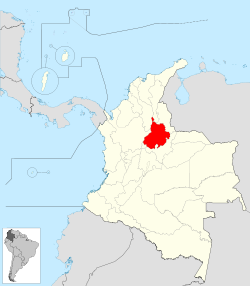- Santander Department
-
Department of Santander
Departamento de Santander— Department — 
Flag
Coat of armsMotto: Santandereanos siempre adelante
(Spanish: People of Santander always ahead)Anthem: Himno de Santander Santander shown in red Coordinates: 7°8′N 73°0′W / 7.133°N 73°WCoordinates: 7°8′N 73°0′W / 7.133°N 73°W Country  Colombia
ColombiaRegion Andes Region Established May 13, 1857 Capital Bucaramanga Largest city Bucaramanga Government – Governor Horacio Serpa Uribe (Colombian Liberal Party) Area – Total 30,537 km2 (11,790.4 sq mi) Area rank 12 Population (2005)[1] – Total 1,916,336 – Rank 6 – Density 62.8/km2 (162.5/sq mi) Time zone UTC-05 ISO 3166 code CO-SAN Provinces 8 Municipalities 87 Website gobernaciondesantander.gov.co Santander is a department of Colombia. Santander inherited the name of one of the nine original states of the United States of Colombia. It is located in the central northern part of the country, east of the Magdalena River, bordered to the south and southeast by Boyacá, to the northeast by Norte de Santander Department, to the north by Cesar Department, and to the west by Bolivar and Antioquia Departments. Its capital is the city of Bucaramanga.
Contents
History
Pre-Colombian
Prior to the arrival of the Spaniards, the territory now known as Santander was inhabited by Amerindian ethnic groups: Muiscas, Chitareros, Laches, Yariguí, Opón, Carare and Guanes.
Their political and social structure was based on Cacicazgos, a federation of tribes led by a cacique, with different social classes. Their main activity was planting maize, beans, yuca, arracacha, cotton, Agave, tobacco, tomato, pineapple, guava, among others. Their agricultural skills were sufficiently developed to take advantage of the different mountainous terrains. The Guanes utilized terraces and an artificial system of irrigation. They had a knowledge of arts and crafts based on ovens to produce ceramics. They had cotton to make clothing and accessories such as hats and bags.
Colonization
Spanish Conqueror Antonio de Lebrija led the first expedition through the area in 1529. The area was later invaded c. 1532 by German Ambrosius Ehinger in a quest to find El Dorado. This disrupted or destroyed many of the Amerindian villages. Some ethnic groups like the Yariguíes, Opones, and Carares fought the conquerors until they became extinct. Explorer Gonzalo Jiménez de Quesada later went to the area in an effort to appease the tribes. The colonization process in the area was started by Martín Galeano who founded the village of Vélez on July 3, 1539 and Pedro de Ursúa and Ortún Velasco founded the village of Pamplona (now part of the Norte de Santander Department) in 1549.
Once the Amerindian tribes were dominated, the Spanish organized the territory based on Cabildos (councils) to maintain the dominance and administer justice in the conquered territory. Amerindians were enslaved and forced to work in agriculture, manufacturing goods, and mines. These two villages functioned as centers for the Cabildos' territories. In 1636 the Cabildo of Vélez was transferred to a new jurisdiction centered on the village of Girón, with an area which went from the Sogamoso River, Río del Oro to the Magdalena River. The village of San Gil was created in 1689, segregated from the Jurisdiction of Vélez. In 1789 the village of Socorro was also segregated from Vélez and they were all put under the mandate of the Province of Tunja, a subdivision of the Viceroyalty of New Granada. On July 9, 1795 the corregimiento of Vélez - San Gil - Socorro was created due to the unsustainability of the Province of Tunja, and local government was established in the village of Socorro.
Notable people
Artists
The most outstanding and representative artists of the Colombian Santander region are Segundo Agelvis, Mario Hernández Prada, Carlos Gómez Castro, Martín Quintero, Oscar Rodríguez Naranjo and Pacheco de Suratá.
Administrative divisions
Provinces
The department is subdivided into provinces:
- Metropolitan Province
- North Soto Province
- Comunera Province
- Guanentá Province
- Vélez Province
- García Rovira Province
- Mares Province
- Carare-Opón Province
Municipalities
References
External links
Santander, Colombia travel guide from Wikitravel
See also
Departments of Colombia  Categories:
Categories:- Santander Department
- Departments of Colombia
- States and territories established in 1857
Wikimedia Foundation. 2010.

